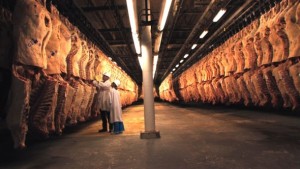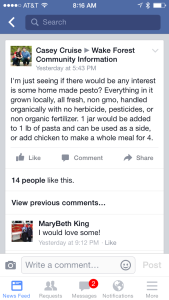Me and the crew, and Sorenne without a tooth (neither hockey nor food safety related).
Category Archives: Food Safety Culture
Life sentence recommended for former PCA president
It’s trite and cliched, but a food safety culture begins at the top of a company. CEOs, COOs, presidents and other business-y people have to value not making customers ill to really establish a working food safety program.
And provide resources to operational staff – the folks who put process and training systems in place to make food safer.
Most companies have internal conflicts on food safety priorities – but the good ones don’t let profits and market trump public health – like Stewart Parnell, former Peanut Corporation of America (PCA) president did.
The shockingly poor food safety culture established by Parnell’s Salmonella-positive-just-ship-it mentality spread throughout the company, resulting in over 700 illnesses and 9 deaths linked to PCA’s products.
According to Korin Miller at Yahoo News, Parnell’s actions have led prosecutors to recommend a life sentence in prison.
The recommendation for his sentencing, which a lawyer for one of the victims called “unprecedented,” was revealed on Wednesday, the Associated Press reports.
After a seven-week trial, Parnell and his brother, food broker Michael Parnell, were both charged with 76 federal counts linked to intentionally shipping peanut products that tested positive for salmonella, CNN reports.
This case is disturbing because salmonella is so potentially dangerous, says food safety specialist Benjamin Chapman, an associate professor at North Carolina State University. “Not everybody who eats salmonella is going to get sick, but the issue is that you don’t know if you’re going to get sick,” he tells Yahoo Health. “That’s why we really don’t want to have salmonella in our food.”
So, while Parnell’s case is unprecedented, the proposed punishment does seem to fit the crime. “We saw through the trial that some really egregious things happened,” says Chapman. “It’s important that people who have knowingly done things to negatively effect other people’s health are held responsible and accountable — it sounds like that’s being done here.”
Ziploc says cook your burger to 125F for rare (and pathogens)
I love Pinterest (and pinned a few things at https://www.pinterest.com/barfblogben/) especially when people get into the food safety world.
Kinsey Porter, one of the folks on the news team behind barfblog showed me this picture (right, exactly ask shown), that she saw on Pinterest this week: Ziploc’s attempt to teach the world how to cook a hamburger.
Except all the suggestions, save one, go against science-based messages. Cooking burgers below 155F for 15 seconds, or 160F = risky burgers.
Ziploc’s parent company SC Johnson say that they are all about families – they might want to provide info on how to keep families safe from foodborne illness. And stick to bags and containers.
Durham County health department looking at mobile vendors
Some of my favorite people are environmental health specialists. Between routine, unscheduled inspections of restaurants and institutions, many spend time working with individuals and small businesses to ensure that they make and sell food safely – and legally. According to WUNC.org, Durham County (NC) environmental health folks are looking to mobile vendors to ensure that they are inspected and are following food safety rules.
The Durham County Department of Public Health wants consumers to know if food from mobile food vendors is coming from somebody who has a permit to sell it.
Environmental Health Director Christopher Salter said the department is also working to inform vendors of food safety regulations, which bar home food prep and selling from a stand without a permit.
Salter said there are 126 mobile food units acting legally in the county. They are heavily scrutinized for healthy food preparation and storage practices. Salter said these vendors not only pose a health risk, but they undercut the businesses of food vendors who follow the legal channels.
“I know that they’re just trying to make a living, they’re trying to get by,” Salter said. “But we have the rules and regulations and what’s right and wrong, and bottom line is we have to protect the public health.”
And it’s not just the mobile vendors, as I peruse my Facebook feed and the Wake Forest Community Information page, there’s food that folks are selling out of their homes. Like cupcakes and pesto.
Market food safety: Can big meat get it?
If companies don’t tell their story, they leave themselves vulnerable to others, who will gladly tell their version of the story.
 NPR says that food companies the world over are paying close attention to the groundswell of support for food transparency, the “know where your food comes from” movement.
NPR says that food companies the world over are paying close attention to the groundswell of support for food transparency, the “know where your food comes from” movement.
JBS, the largest meat producer in the world, is beginning to take notice as well.
But executives with JBS USA, the North American arm of its Brazilian parent company, at the same time acknowledge that the very nature of their business is grisly, gory and sometimes unpalatable.
“Part of you says, ‘I need to learn how to bring the packing house into the consumer’s living room,'” says Bill Rupp, president of the company’s beef division. “Then at the same time, you think of all the pitfalls of trying to explain to consumers how we harvest their meat.”
“I think in today’s society, the consumer wants to know more and more where their food comes from. And food companies are slowly adopting toward that,” says Cameron Bruett, JBS USA spokesman. “But I think we need to do a better job.”
JBS owns numerous plants cross the Midwest, South and West of the U.S., as well as worldwide. The JBS meatpacking plant in Greeley, Colo., is an imposing building. Conveyor belts snake through the concrete structure. But it’s not an assembly line. Workers in blood-spattered smocks disassemble cattle, breaking down whole animals into cuts of meat.
During a guided tour for journalists, the plant’s manager, Bill Danley, points to a line of men carving the animal’s head. “These guys here, what they’re doing is, they’re taking the cheek meat off,” Danley says. “There’s head meat on top of that. A lot of your taco filler is made out of cheek meat and head meat.”
Taco meat is just the beginning. This one cow is destined to be sirloin at steakhouses, ground hamburger at local grocery stores and leather for car seats.
JBS spokesman Bruett says for a long time, beef has been a commodity, shipped out from meatpacking plants in boxes and rebranded at grocery stores and restaurants. Bruett says when your immediate customers are other businesses, there’s little value in telling your story.
Use a thermometer, color sucks: UK FSA says don’t serve your duck pink
Color is a lousy indicator.
But that doesn’t stop the taxpayer-funded UK Food Standards Agency from issuing nonsensical advice.
 I’ve asked the UK food safety types why they don’t recommend that people use thermometers – as is the advice in the U.S., Canada and Australia – and the response is usually along the lines of, people can’t handle such complicated information.
I’ve asked the UK food safety types why they don’t recommend that people use thermometers – as is the advice in the U.S., Canada and Australia – and the response is usually along the lines of, people can’t handle such complicated information.
A colleague received similar advice yesterday from the UK FSA.
Arrogant bullshit.
And not science-based.
The Telegraph reported today that duck should never be served pink as diners could be poisoned by a potential deadly bug more commonly associated with chicken, food officials have said.
While many upmarket restaurants recommend their duck dishes medium-rare, the Food Standards Agency said the poultry should always be cooked “thoroughly” at home.
It warned that the prevalence of the campylobacter bug among ducks was “not dissimilar” to the levels among chickens, where seven in 10 birds are infected.
The bacterium, which makes 280,000 ill every year, is only killed when meat is fully cooked.
On Wednesday the food watchdog said it was concerned that there was a public misconception that duck was different to chicken in that it could safely be served pink.
There’s a public misconception because the bureaucrats are not offering clear, evidence-based information.
Stick it in.
Food safety memories: Inside Out
 Instead it too often involves anger, fear, disgust and sadness.
Instead it too often involves anger, fear, disgust and sadness.
That’s the plot of the new Pixar movie, Inside Out.
Not the food bit, but the emotions humans use to remember things (and why Lewis Black’s angry man character in the film is so compelling).
The movie tells the story of 11-year-old Riley, a hockey player from Minnesota, and her difficulty dealing with a family move to San Francisco.
They had me at girl hockey player, since all five of my daughters play(ed).
My most compelling food memory is this: when my first child was born at home, 28 years ago, I remember walking in Guelph with her 12 hours after birth, and then a couple of friends came over.
I cooked a stuffed trout.
I still remember that stuffed trout as the best ever, but that was probably fuelled by the emotions of the first kid.
Inside Out plays on similar emotions, as did Ratatouille, another Pixar film, in 2007.
Carole Peterson, a professor of psychology at Memorial University in Newfoundland, says that, “Children have a very good memory system. But whether or not something hangs around long-term depends on several other factors” such as whether the memory “has emotion infused in it,” and whether the memory is coherent.
Inside Out gets this right.
 Research from Eric Kandel’s lab at Columbia University Medical Center (CUMC) has uncovered further evidence of a system in the brain that persistently maintains memories for long periods of time. Paradoxically, it works in the same way as mechanisms that cause mad cow disease, kuru, and other degenerative brain diseases.
Research from Eric Kandel’s lab at Columbia University Medical Center (CUMC) has uncovered further evidence of a system in the brain that persistently maintains memories for long periods of time. Paradoxically, it works in the same way as mechanisms that cause mad cow disease, kuru, and other degenerative brain diseases.
In four papers published in Neuron and Cell Reports, Dr. Kandel’s laboratory show how prion-like proteins – similar to the prions behind mad cow disease in cattle and Creutzfeld-Jakob disease in humans – are critical for maintaining long-term memories in mice, and probably in other mammals.
When long-term memories are created in the brain, new connections are made between neurons to store the memory. But those physical connections must be maintained for a memory to persist, or else they will disintegrate and the memory will disappear within days. Many researchers have searched for molecules that maintain long-term memory, but their identity has remained elusive.
People learn through and retain stories. Technology is just a tool to deliver the story
Chapman and I figured that out in the early 2000s, going to the bathroom in the restaurant after playing hockey and seeing sports pages above urinals, and ultimately convincing the manager to post food safety stories.
As part of his PhD research, Chapman partnered with a food service company in Canada and placed small video cameras in unobtrusive spots around eight food-service kitchens that volunteered to participate in the study. There were as many as eight cameras in each kitchen, which recorded directly to computer files and later reviewed by Chapman and others.
 Food safety inforsheets, highlighting the importance of handwashing or preventing cross-contamination, for example, were then introduced into the kitchens, and video was again collected. We found that cross-contamination events decreased by 20 per cent, and handwashing attempts increased by 7 per cent.
Food safety inforsheets, highlighting the importance of handwashing or preventing cross-contamination, for example, were then introduced into the kitchens, and video was again collected. We found that cross-contamination events decreased by 20 per cent, and handwashing attempts increased by 7 per cent.
Tell a food safety story, make it compelling.
And involve female hockey players.
Dr. Douglas Powell is a former professor of food safety who shops, cooks and ferments from his home in Brisbane, Australia.
Food Safety Talk 78: Brogues are low risk
Food Safety Talk, a bi-weekly podcast for food safety nerds, by food safety nerds. The podcast is hosted by Ben Chapman and barfblog contributor Don Schaffner, Extension Specialist in Food Science and Professor at Rutgers University. Every two weeks or so, Ben and Don get together virtually and talk for about an hour. They talk about what’s on their minds or in the news regarding food safety, and popular culture. They strive to be relevant, funny and informative — sometimes they succeed. You can download the audio recordings right from the website, or subscribe using iTunes.
The show opens with the guys reminiscing about their visit to Southern California and the Hopscotch Tavern where they witnessed a Fark worthy car chase on TV.
Ben shared his love of Top 40 music , and his worries about exposing his kids to inappropriate music like Beyoncé or Sublime. 
From there the discussion moves to the value of real world experiences like those detailed in Kitchen Confidential, Heat, or by Gord Surgeoner during his retirement dinner.
The food safety talk begins in earnest with a discussion of Hepatitis A illnesses linked to frozen berries in Australia, and Don shared his back of the envelope quantitative microbial risk assessment for frozen berries based on this article. This was followed by a discussion on why viruses might be such a problem in frozen berries, and frozen food safety risk management in general.
Next up is an exploration of Listeria in public lavatories based on this peer reviewed publication. The conversation then devolves into Shoe Safety Talk, and the risks posed by brogues, not broughs, but the brogue shoe.
The After Dark includes a mention of Roderick’s Rendezvous, The Dan Benjamin Hour, and Don finally remembers the name of Battle Creek.
We pay tax dollars for this? Safe Food Queensland sucks
Safe Food Queensland: What do you get when you cross a Smurf with cheese? Blue Cheese. #cheesejoke #jokes #food #cheese
 Safe Food Queensland should maybe focus on providing reports on the E. coli O157 outbreak that sickened 50 at the Ekka in 2013. Follow-up? Nothing.
Safe Food Queensland should maybe focus on providing reports on the E. coli O157 outbreak that sickened 50 at the Ekka in 2013. Follow-up? Nothing.
In November 2013, at least 220 people were felled by salmonella and one was killed at Melbourne Cup functions, all linked to raw egg-based dishes served by Piccalilli Catering. Follow-up? Nothing.
In January 2015 at least 130 diners were stricken with salmonella after dining at Brisbane’s Chin Chin Chinese Restaurant. Dozens were hospitalised. Follow-up? Nothing.
In March 2015, 250 teachers contracted salmonella at a conference and an additional 20 people were sickened on the Gold Coast from the same egg supplier. Follow-up? Nothing.
But way to make bad, taxpayer-funded jokes, Safe Food Queensland.
Food safety costs money: OSI Group nearing $1 bn
US based meat supplier OSI Group has lost around six billion yuan ($967.6 million) since a food safety scandal in China last summer, a senior China-based executive for the firm told the official Xinhua news agency.
 The report, published late on Tuesday, underlines how severe the impact of food safety scares can be in China, which has seen a series of stomach churning scandals from decades old meat to milk tainted with industrial chemical melamine which led to the deaths of at least six infants.
The report, published late on Tuesday, underlines how severe the impact of food safety scares can be in China, which has seen a series of stomach churning scandals from decades old meat to milk tainted with industrial chemical melamine which led to the deaths of at least six infants.
OSI Group said in January it had lost “hundreds of millions of dollars” in lost revenue in China since an undercover local media report alleged to show workers at its Shanghai Husi Food Co Ltd plant using out-of-date meat and doctoring production dates.
Operations at Shanghai Husi, which supplied meat to McDonald’s Corp and Yum Brands Inc, were suspended following the reports. Local authorities launched an investigation into the matter and OSI’s chief executive said he was appalled over misteps at the plant.
OSI China’s vice president Lu Yong told Xinhua on Tuesday the firm had suffered the near $1 billion loss since the scandal last July and that many factories were still suspended




